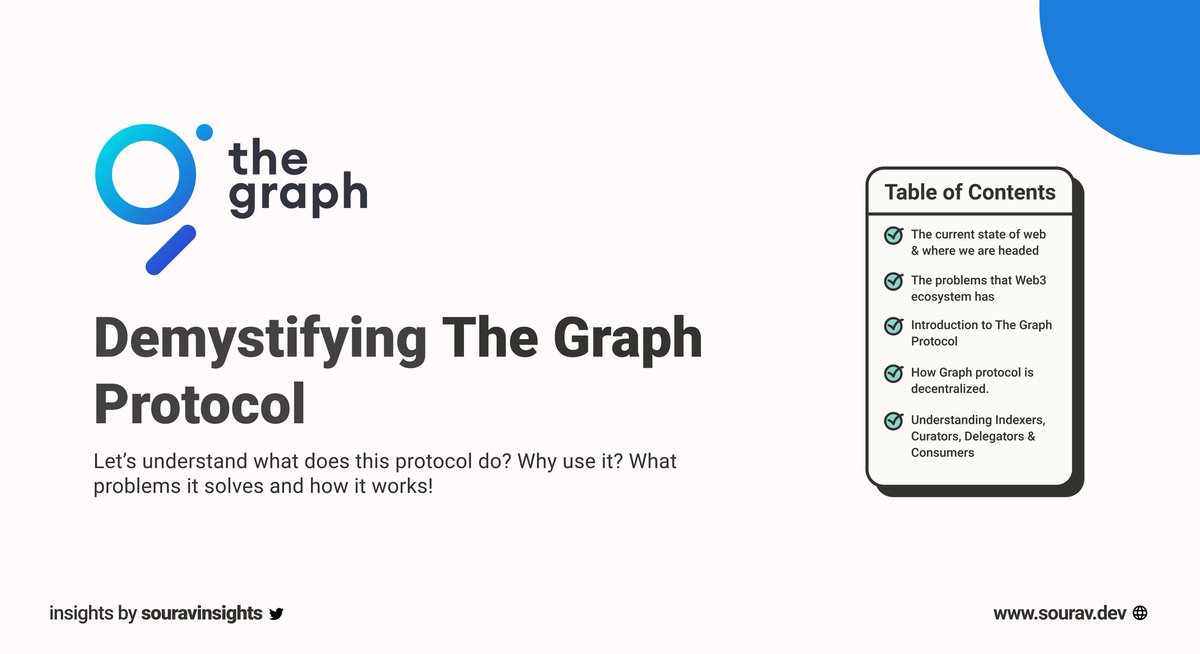Let's demystify @graphprotocol and understand #what does this do? #Why developers use it? What problems it solves, #how it works and how to get started!
A #thread 🧵 👇
A #thread 🧵 👇

1/ The #web 🌐 of today has a client-server architecture that grants tremendous power to whoever runs the server. This favors #centralization! But we may have reached the peak of centralization & the power is now slowly getting distributed!
2/ Web3 is the new layer that will enable #decentralization on a mass scale! Blockchains like #ethereum will be the north star of this new movement. 🚀
3/ In blockchains like #ethereum, all the #transaction data is accessible to everyone! But there are vast amounts of raw data on ethereum which needs to be stored in a format that can be #easily & #efficiently queried. However, it's rarely the case. 😶
4/ Teams are getting around this gap by building #centralized indexing #servers that pull data from #ethereum, store it in a database, & expose it over an #API. Which is something against the #decentralization notion we are thriving for.
5/ Here's where @graphprotocol shines! Think of it as the open data layer for public #blockchains like #ethereum & storage networks like @IPFS & @FilFoundation, making it easy for #developers to pull information & serve that information to their users, quickly & efficiently. 😬
6/ But how is @graphprotocol is #decentralized? Well, in order to do this, the power should be distributed, right? There are many different roles in The Graph Network, like: #Indexing, #Curating, #Delegating & #Consuming. Huh! So many jargons! 😶 Let's tear them down one by one!
7/ #Indexers are node operators in The Graph Network that stake Graph Tokens (GRT) in order to provide indexing & query processing services. Indexers earn query fees & indexer rewards for their services. To be an Indexer on The Graph network, you need to be able to run the node.
8/ #Curators are subgraph developers, data consumers or #community members who signal to Indexers which #APIs should be indexed by The Graph Network. They use their knowledge of the #blockchain ecosystem, applications & consumers to identify the most reliable data sources.
9/ #Curators deposit GRT to signal on a specific #subgraph & earn a portion of query #fees for the subgraphs they signal on — this incentivizes the highest quality data sources. We will go more in-depth of curators make money in another thread! Stick around. 😬
10/ Okay, it's 2 times I've used #subgraph! Let's talk about that now! Subgraphs define what data is indexed from #ethereum & how it is stored. Once a subgraph is deployed, it will form a part of a global graph of #blockchain data.
11/ #Delegators are individuals who would like to contribute to securing the #network but do not want to run a Graph Node themselves. Delegators contribute by delegating #GRT to existing #Indexers, and they earn a portion of query #fees and indexing #rewards in return. 💰
12/ #Consumers are the end-users who query #subgraphs & pay query fees to the Indexers, Curators & Delegators. Consumers are likely to be #developers or projects themselves that cover query #fees for their applications just like they would do for #AWS or any other cloud service.
End of the thread! I'm just getting down to this whole new rabbit hole & I'm open to discuss anything that I might have missed! 🤗 For people who are getting started (like me), check out the official blog for an in-depth understanding 👇
thegraph.com/blog/the-graph… by @graphprotocol
thegraph.com/blog/the-graph… by @graphprotocol
Finally, do retweet to spread knowledge & follow me @souravinsights for more threads about #decentralization #crypto, #DeFi, #finance and #DEX! ✍️
Have a nice day! ❤️
Have a nice day! ❤️
Received an overwhelming response on this #thread! 😬 Must be because of the #GRT fans out there. 🙏 I'm pumped up to write my next thread which is about a new fully #decentralized #AMM @TimeswapLabs. We'll discuss how it works & what's so exciting about it. Stay tuned! 🥳
• • •
Missing some Tweet in this thread? You can try to
force a refresh





